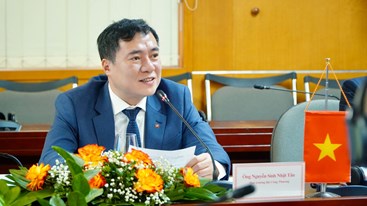Friday, 03/05/2024 | 03:00 GMT+7
The Tien
Dat Mui Ne Resort in

Tien Dat
Mui Ne was designed to combine modern and traditional styles to create comfort
and delightfulness for guests. The resort looks to the sea where there is much
fresh air, natural light and natural wind, which is a large source of energy
that makes the resort bright and cool without consuming much electricity.
 Tran Trong
Nho, the general director of Tien Dat Mui Ne, said that with the efforts of the
resort staff members and customers’ understanding of energy conservation, his
facility saved an average of 30.9 percent of electricity annually. He said,
“Apart from advice from experts, we have tried to learn about energy
efficiency. Our business philosophy is to improve administration and use less
energy while ensuring the highest convenience for customers.”
Tran Trong
Nho, the general director of Tien Dat Mui Ne, said that with the efforts of the
resort staff members and customers’ understanding of energy conservation, his
facility saved an average of 30.9 percent of electricity annually. He said,
“Apart from advice from experts, we have tried to learn about energy
efficiency. Our business philosophy is to improve administration and use less
energy while ensuring the highest convenience for customers.”
Energy
conservation begins from architecture
To make the
most of natural sources of energy the management of Tien Dat Mui Ne chose
environmentally construction friendly materials in hopes to make guests close
to nature and create a special style for the resort.
Most construction materials are bamboo, wood and leaves that lead natural light and air to every room and make a difference between coastal resorts like Tien Dat Mui Ne and urban areas which are densely populated and stuffy. The design that made the most of environmentally friendly construction materials allows natural wind to flow deep into the resort, which together with numerous trees there makes the resort cool without any air-conditioner even on hot days.

To minimize
solar radiation, the architects for Tien Dat Mui Ne were very concerned about
walling, roofing and curtains. Tiled/cottage roofs and bamboo shades are
suitable for the tropical climate in
In
addition, good arrangement of windows, doors and shutters contributes
importantly to energy efficiency in the resort.
Technical
solutions
With many
service facilities like restaurants, bars and massage/beauty salons, Tien Dat
Mui Ne consumed a large volume of power annually. Statistics by the resort
authority indicate that the resort consumed about 285,000 kWh in 2008 costing
VND467 million.
Tien Dat Mui Ne was open in 1999 as a destination of the Ham Tien –
Mui Ne Binh Thuan key tourist route. It is the best and the most convenient
resort in the south offering a wide array of services such as restaurants,
billiard, tennis, swimming and more that meet four-star standard. Tien Dat
Mui Ne won a national first prize for “Tropical Buildings” in 2009 from the
Ministry of Industry and Trade and a second prize for “Tropical Buildings” in
Southeast Asia under the contest “2010 Energy Efficient Buildings” held by
the |
Because
there is much sunlight in Mui Ne, the architects made use of solar energy for
the resort. There are nine solar water heaters in the resort that provide a
minimum 2,700 liters of hot water daily and help the resort save more than
61,000 kWh worth VND50 million annually.
Apart from natural
light, most lamps in the resort are 5W compact and 36W fluorescent lamps with
shades that create reflected light. As the resort uses energy saving appliances
and closely observes regulations on power system operation, the resort saved 28
percent of power for lighting annually.
Another
success went to dimmers that allow the light and fan systems to save more than
2,500 kWh annually.
Although
the resort has made the most of natural wind, it has had to install many air
conditioners that have consumed much power. However, all outdoor units of
air-conditioners were installed in cool places under trees where it is easy to
clean them. In so doing, the resort has also saved power for the air
conditioning system.
With all
these energy conservation solutions, Tien Dat Mui Ne saved about 82,000 kWh
worth more than VND145 million annually and contributed actively to environment
protection by reducing about 68 tonnes of CO2 annually.


.png?w=367&h=206&mode=crop)





.jpg?w=367&h=206&mode=crop) Energy efficiency and conservation usage is an important aspect of the national energy development strategy
05/03/2024
Energy efficiency and conservation usage is an important aspect of the national energy development strategy
05/03/2024
 Challenges and Opportunities to promote energy efficiency market in Vietnam
Challenges and Opportunities to promote energy efficiency market in Vietnam
 The Ministry of Industry and Trade requests government agencies to coordinate in organizing Earth Hour 2024
The Ministry of Industry and Trade requests government agencies to coordinate in organizing Earth Hour 2024
 Consultation on Energy Efficiency Boiler Catalogue and Wood Drying Guideline
Consultation on Energy Efficiency Boiler Catalogue and Wood Drying Guideline
 Son Ha Co., Ltd, applies energy efficiency and conservation measures
Son Ha Co., Ltd, applies energy efficiency and conservation measures
.png?w=367&h=206&mode=crop) Request for expression of interest - C2.1.13: Capacity Building on energy efficiency policies development
Request for expression of interest - C2.1.13: Capacity Building on energy efficiency policies development
 Phuc Kien Co., Ltd., is effectively implementing energy-saving measures
Phuc Kien Co., Ltd., is effectively implementing energy-saving measures
 Request for expression of interest - C2.1.12: Independent monitoring of safeguards implementation
Request for expression of interest - C2.1.12: Independent monitoring of safeguards implementation